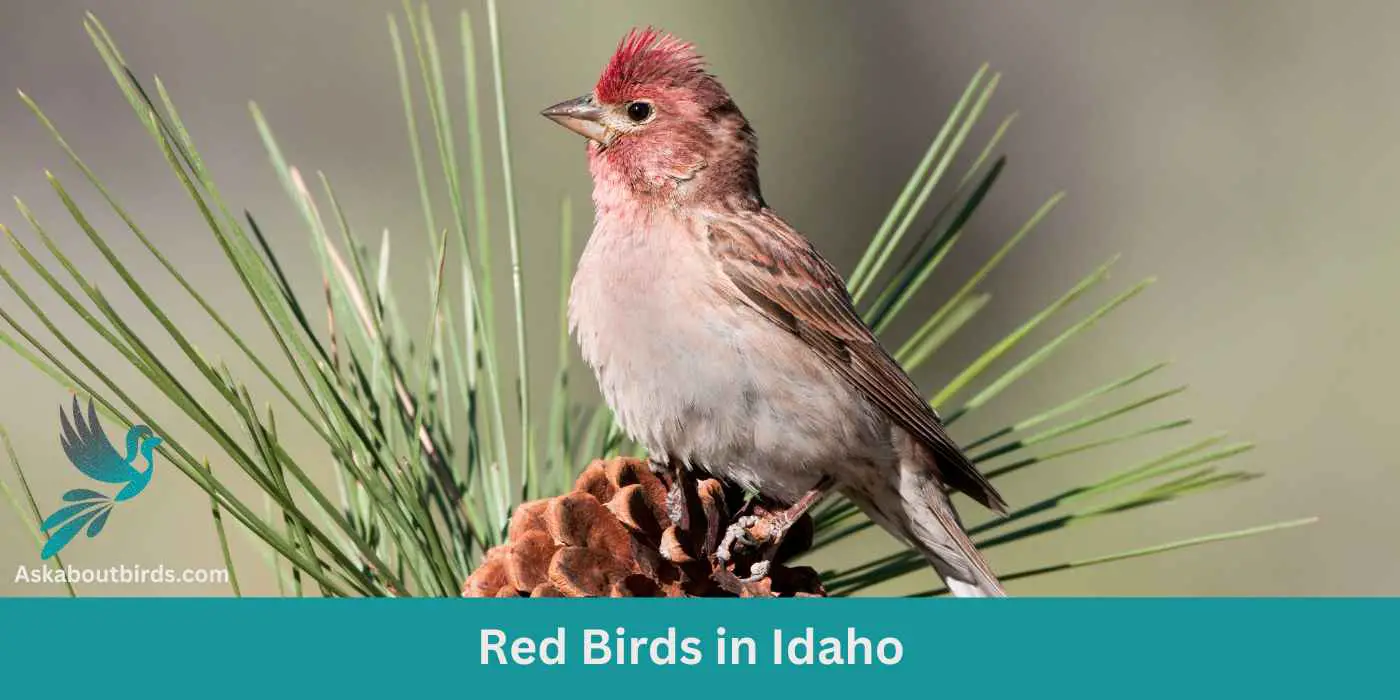Nestled amidst rugged mountains and pristine lakes, Idaho is not just a haven for adventurers, but also a sanctuary for many vibrant bird species. Among them are the striking red birds that add a splash of color to the Gem State’s vast landscapes.
Dive into our curated list of 8 mesmerizing red birds found in Idaho and enhance your birdwatching journey with our complimentary photo guide. From the high-altitude pine forests to the serene riverbanks, get ready to witness nature’s red-hued marvels in all their glory.
Red Birds Found In Idaho
The confluence of the Pacific flyway and the Rocky Mountains means migratory paths intersect over Idaho’s skies, making it a hotspot for bird enthusiasts. From dense coniferous forests to riparian wetlands, each environment invites a unique set of bird species, allowing for a kaleidoscope of colors and songs across the Gem State.
Northern Cardinal


| Feature | Measurement |
|---|---|
| Scientific Name | Cardinalis cardinalis |
| Length | 8.3 – 9.1 in |
| Wingspan | 9.8 – 12.2 in |
| Weight | 1.19 – 2.29 oz |
The Northern Cardinal is an iconic North American bird, easily recognized by its vibrant color and melodious song.
Appearance: Male Northern Cardinals are a brilliant scarlet red, while females display a more subdued reddish olive. Both sexes have a distinctive black ‘mask’ on their face around the bill and a pointed crest on their head. The bird’s beak is robust, cone-shaped, and bright orange in color.
Diet: Northern Cardinals are primarily granivorous, with a diet largely consisting of seeds and grains. They also eat fruits and insects. These birds typically feed off the ground and are frequent visitors to bird feeders.
Reproduction: Northern Cardinals are monogamous, and a pair will breed together for life. The female typically builds a well-hidden nest in a dense thicket or shrub. She lays 2-5 eggs per clutch, which she incubates for around two weeks.
Summer Tanager


| Feature | Measurement |
|---|---|
| Scientific Name | Piranga rubra |
| Length | 6.7 in |
| Wingspan | 28 to 30 cm |
| Weight | 29 g |
The Summer Tanager is a medium-sized songbird admired for its radiant plumage and melodious song.
Appearance: Male Summer Tanagers are an impressive bright red, while females and juveniles present a softer, yellow-orange color. Both genders have a large, slightly hooked bill and relatively short tail.
Diet: Summer Tanagers primarily feed on insects, including bees and wasps, which they catch in flight or pick off vegetation. They are also known to eat fruits and berries, making them helpful in controlling pest populations and seed dispersal.
Reproduction: The female Summer Tanager builds a loose, shallow cup-shaped nest out of twigs and grass, usually hidden in the foliage of trees. The female typically lays 3-5 eggs, which she will incubate for about two weeks.
Scarlet Tanager


| Feature | Measurement |
|---|---|
| Scientific Name | Piranga olivacea |
| Length | 6.3 to 7.5 in |
| Wingspan | 9.8 to 11.8 in |
| Weight | 23.5 to 38 g |
The Scarlet Tanager is a strikingly colorful bird known for its brilliant plumage and distinctive song.
Appearance: Male Scarlet Tanagers are notable for their vibrant scarlet bodies contrasted with black wings and tail, making them one of the most intensely colored birds. Females and juveniles, on the other hand, have a subdued olive-yellow body color with darker wings and tail.
Diet: The diet of the Scarlet Tanager is largely made up of insects, including beetles, cicadas, aphids, and others. They are adept flycatchers, seizing insects in mid-air or picking them off foliage. They also consume fruits and berries, especially during migration and in their winter habitats.
Reproduction: The female Scarlet Tanager builds a cup-shaped nest using twigs, rootlets, and grass, typically well-hidden in the dense foliage of trees. She lays 3 to 5 eggs and incubates them for about two weeks.
Pine Grosbeak

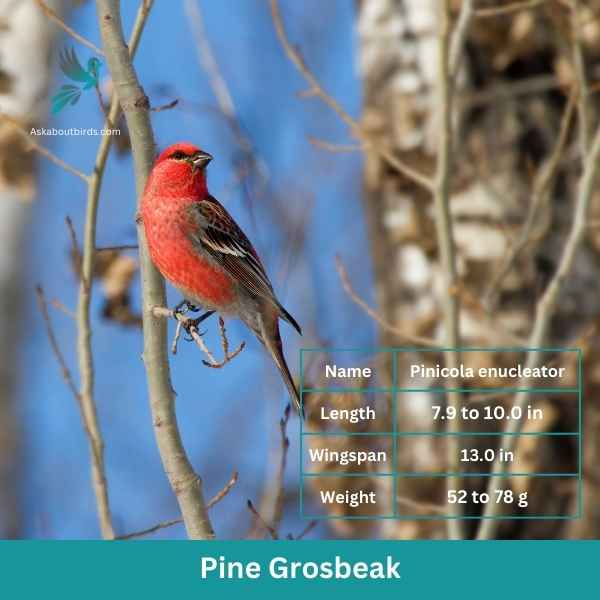
| Feature | Measurement |
|---|---|
| Scientific Name | Pinicola enucleator |
| Length | 7.9 to 10.0 in |
| Wingspan | 13.0 in |
| Weight | 52 to 78 g |
The Pine Grosbeak is a striking bird native to the northern regions of North America, often found in coniferous forests. Both males and females have a plump and robust body with a large beak adapted for eating seeds. The male Pine Grosbeak displays a vibrant reddish-pink plumage, while the female has a more subdued grayish-brown coloration.
These birds are typically seen in small flocks, foraging for food in trees and on the ground. They have a preference for seeds, particularly those from various conifer species. The Pine Grosbeak uses its strong bill to crack open the cones of tall trees and extract the seeds, but they also consume berries and small fruits when available.
Red Crossbill
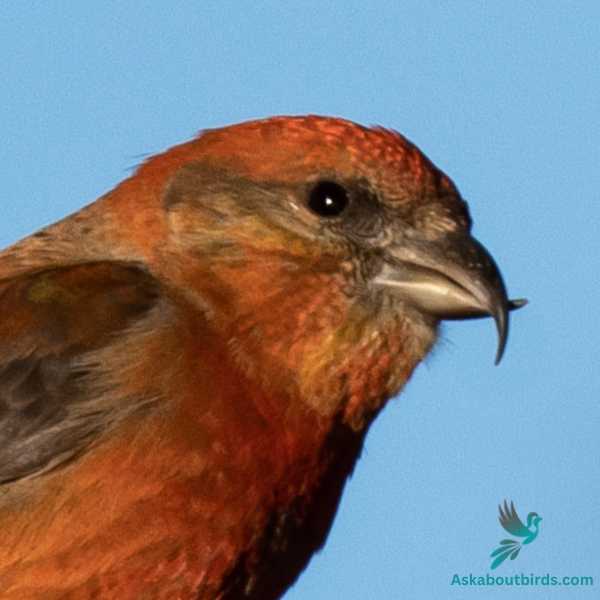

| Feature | Measurement |
|---|---|
| Scientific Name | Loxia curvirostra |
| Length | 20 cm |
| Wingspan | 27–29 cm |
| Weight | 40-53 g |
The Red Crossbill is a peculiar bird species, celebrated for its unique beak structure and vibrant coloration.
Appearance: Red Crossbills are named for their distinctive crossed mandibles, which are adapted to extracting seeds from conifer cones. Male Red Crossbills are usually bright red or orange, while females and juveniles are greenish-yellow. All have dark wings and notched tails.
Diet: The diet of the Red Crossbill is primarily composed of conifer seeds, their unique beak allowing them to access these seeds with ease. This diet includes seeds from pine, spruce, and other types of coniferous trees. They are also known to consume some insects.
Reproduction: Red Crossbills are known for their flexible breeding season, which can occur any time of the year when there is an abundance of food. They typically nest in conifers, where the female lays a clutch of 3 to 4 eggs.
Cassin’s Finch

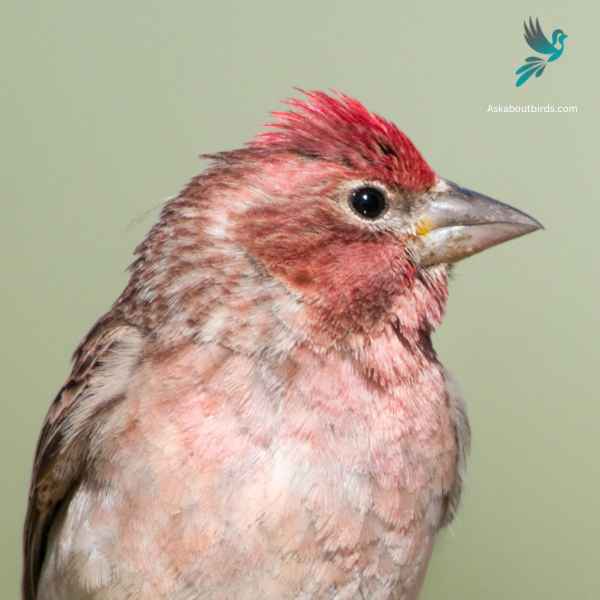
| Feature | Measurement |
|---|---|
| Scientific Name | Haemorhous cassinii |
| Length | 6.0-6.5 in |
| Wingspan | 9.5-10.5 in |
| Weight | 0.8-1.0 oz |
The Cassin’s Finch is a small songbird known for its melodic song and affinity for high-elevation forests.
Appearance: Male Cassin’s Finches are pinkish-red on the crown and throat, contrasting with their streaked brown back and wings. Females lack the bright coloring, appearing streaked brown throughout with a pale eyebrow stripe. Both sexes have a notched tail and a slightly curved bill.
Diet: Cassin’s Finches mainly feed on seeds, particularly from conifers. They also eat insects, especially during the breeding season. Their feeding habits often bring them to bird feeders where they readily eat sunflower seeds.
Reproduction: Cassin’s Finches nest in trees, preferring coniferous forests. The nest is made from twigs, grasses, and feathers. Typically, the female lays 3 to 5 eggs and handles most of the incubation. Both parents partake in feeding the fledglings once they hatch.
House Finch


| Feature | Measurement |
|---|---|
| Scientific Name | Haemorhous mexicanus |
| Length | 5–6 in |
| Wingspan | 8–10 in |
| Weight | 0.6–0.9 oz |
The House Finch is a small songbird widely distributed across North America and is commonly found in urban and suburban areas.
Appearance: Males of this species are brightly colored with crimson faces and throats, which can extend to the chest and back, while their flanks have streaks. The female is streaked brown and lacks the red coloring. Both have a square-tipped tail and a distinctively long, flat-topped bill.
Diet: House Finches primarily eat seeds, grains, and berries. They have a particular fondness for sunflower seeds and can be commonly seen at bird feeders. Occasionally, they will also consume insects, especially during the breeding season.
Reproduction: House Finches are cavity-nesters and might choose ledges, vents, ledges, and other urban settings. They might also utilize trees or shrubs. Their nests can be made of a wide array of materials, from feathers to twigs.
Western Tanager

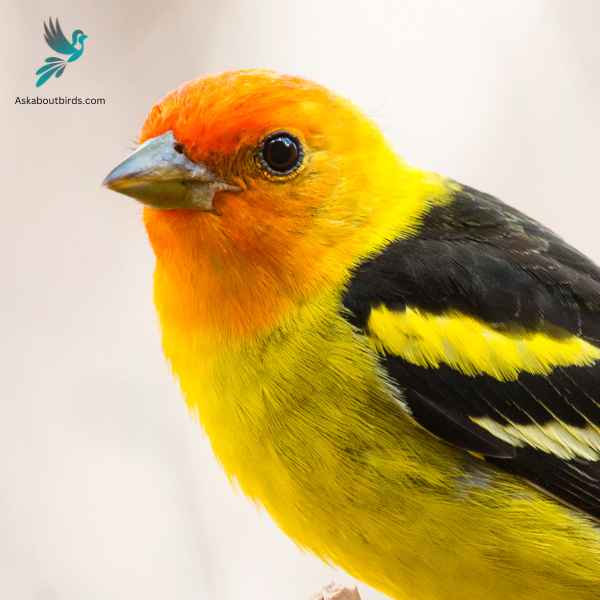
| Feature | Measurement |
|---|---|
| Scientific Name | Piranga ludoviciana |
| Length | 6.3-7.5 in |
| Wingspan | 11.5 in |
| Weight | 24-36 g |
The Western Tanager is a vibrant songbird that graces the forests and woodlands of the western regions of North America, enchanting observers with its colorful plumage and melodious song.
Appearance: The male Western Tanager is renowned for its bright yellow body contrasted with a striking red head and black wings and tail. The females are more subdued in hue, primarily being yellow with grayish wings and back, and lacking the brilliant red head of the males.
Diet: Western Tanagers primarily feed on insects, especially when breeding, but they also incorporate a significant amount of fruits and berries into their diet, especially during migration and winter.
Reproduction: Western Tanagers build their nests high in coniferous trees, often well concealed from potential predators. The female usually lays a clutch of 3 to 5 eggs and takes the primary role in incubation, while both parents are involved in feeding the chicks after they hatch.
Where to Spot Idaho’s Red Birds
Idaho’s Varied Landscapes: Prime Spots for Bird Watching Enthusiasts
- Coeur d’Alene’s Migratory Bird Viewing Area: Situated near the Washington border, this area boasts wetlands and forests perfect for spotting waterfowl and songbirds alike.
- Camas National Wildlife Refuge: Located in the eastern part of the state, this refuge is a critical stop for migrating waterfowl. Spring and fall are peak seasons here, with wetlands alive with the sights and sounds of numerous bird species.
- Morley Nelson Snake River Birds of Prey National Conservation Area: Just south of Boise, this area is renowned for its high density of nesting raptors, making it a paradise for bird watchers keen on birds of prey.
- Bear Lake National Wildlife Refuge: This southeastern refuge is particularly known for its waterfowl and wading birds, offering a tranquil setting for bird watching.
- Silver Creek Preserve: A gem in central Idaho, this location is famous for its large diversity of bird species, including various red birds, against a backdrop of serene spring-fed creeks and expansive wetlands.
| State’s Red Birds | Top Spots for Red Birds |
|---|---|
| Montana’s Red birds | 1. Lee Metcalf National Wildlife Refuge 2. Benton Lake National Wildlife Refuge 3. Ninepipe National Wildlife Refuge |
| Wyoming’s Red birds | 1. Seedskadee National Wildlife Refuge 2. Bighorn Canyon National Recreation Area 3. Jackson Hole |
| Utah’s Red birds | 1. Bear River Migratory Bird Refuge 2. Antelope Island State Park 3. Nebo Loop Scenic Byway |
| Nevada’s Red birds | 1. Stillwater National Wildlife Refuge 2. Ruby Lake National Wildlife Refuge 3. Ash Meadows National Wildlife Refuge |
| Oregon’s Red birds | 1. Malheur National Wildlife Refuge 2. Klamath Basin Refuges 3. Ridgefield National Wildlife Refuge |
| Washington’s Red birds | 1. Nisqually National Wildlife Refuge 2. Skagit Wildlife Area 3. Turnbull National Wildlife Refuge |
FAQs on Red Bird Species Found in Idaho
What are some common red birds that can be spotted in Idaho?
In Idaho, bird enthusiasts can frequently spot bright red birds such as the Pine Grosbeak, known for its red plumage and thick bill, and the widespread Red Crossbill. The Northern Flicker, primarily found in open country and city parks, is another recognizable bird with its brown plumage and a red crown. For those near water bodies in southern Idaho, the Cinnamon Teal, a large bird with vibrant red plumage, is a common sight.
The widespread Red Crossbill, which frequents evergreen forests in Idaho, is closely related to the Pine Grosbeak. Known for its unique red crown and thick bill, this bird is a year-round resident of the state, feeding on pine cones and small insects.
How can residents attract red birds to their backyards in Idaho?
Idaho residents can attract red birds like the Pine Grosbeak, Northern Flicker, and the rare Painted Bunting by setting up backyard feeders filled with black oil sunflower seeds. Planting shade trees and maintaining dense vegetation or forest edges around properties can also create an inviting habitat. Furthermore, placing bird baths or small water sources can attract Cinnamon Teals and other birds, especially during the warmer months.
Are there any red birds in Idaho that prefer evergreen forests and are known for their distinctive white features?
Yes, the White-winged Crossbill is a distinctive bird found in evergreen forests of Idaho. It is recognizable by its red plumage combined with white wing bars and large white wing patches. These birds typically move in large flocks and are known for their unique ability to extract seeds from pine cones, thanks to their thick bill.

